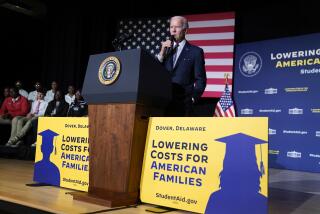10 big banks get OK to repay $68 billion in bailout money
The Treasury Department’s decision Tuesday to allow 10 major banks to repay their federal bailout money is a measure of how much the fear of a wholesale collapse of the banking system has receded since last fall.
Although banks continue to receive many types of federal support including loans, banks are increasingly able to attract private capital, to trade securities and to give consumers confidence that their deposits are safe, experts said.
The progress is crucial to a recovery from the recession that is gripping the auto industry and other nonbanking sectors of the economy. From the very beginning of the financial meltdown, economists have warned that a crippled banking system propped up only by an endless flow of taxpayer money would be an anchor on the rest of the economy.
“I think it’s fair to say that the force of the global storm is receding a bit,” Treasury Secretary Timothy F. Geithner said. “We want to see a financial system that’s strong enough that it’s going to be able to support a reasonable recovery. And we’re in a much better position today than I think we could have expected to have been . . . six weeks ago, two months ago, three months ago, four months ago.”
The repayments also demonstrate that the much-maligned Trouble Asset Relief Program, hastily concocted in the desperate days of last October, will not be a black hole for taxpayers.
The 10 banks could repay as much as $68 billion of the $199 billion invested in more than 600 banks under the capital purchase program, a part of TARP. In addition, the federal government has received $4.5 billion in dividends on its investments, earning a higher interest rate than it currently pays to borrow. The repayments will go into the Treasury Department’s general account, allowing flexibility to reuse the money to stabilize the financial system.
But Tuesday’s milestone hardly signals that the U.S. banking system is on a path to normalcy any time soon, economists say. Three of the nation’s biggest banks aren’t on the list of those healthy enough to repay the funds: Citigroup Inc., Bank of America Corp. and Wells Fargo & Co. All three were told by regulators last month to raise additional capital.
One Treasury official warned that the optimism expressed by Geithner is tempered by the reality that many banks that are not considered too big to fail are at risk of doing just that. This year, 37 banks have failed, up from 25 for all of 2008 and only three in 2007. Among the failures this year was Bank United in Florida, which had assets of $12.8 billion when it collapsed last month in the downdraft of the Florida real estate market.
“The entire risk-management structure of some of these banks is completely out of balance,” said the official, who asked not to be named because he wasn’t authorized to speak publicly.
What’s more, the outlook is for a continued high rate of bank failures, as the economy continues to reel under heavy job losses, a weak commercial real estate sector and falling home prices.
“Just because 10 banks are repaying TARP and appear to be off government oversight doesn’t mean the financial system is cured,” said William Spiegel, managing director at Pine Brook Road Partners, a New York private equity firm that specializes in financial and energy companies.
Simon Johnson, a professor at MIT Sloan School of Management, said the move by the 10 banks seeking to repay federal bailout money does signal “a restoration of their ability to raise capital,” which is a crucially important development in the financial recovery.
“If the world was just the U.S., I would say we have turned the corner,” Johnson said. “But the wild cards are in Europe, and there are a lot of things that can still go wrong there, particularly in Eastern Europe. That is a bit of a nail biter.”
The Treasury did not identify the institutions authorized to make repayments, but the 10 banks put out their own disclosures. They are American Express Co., BB&T; Corp., Bank of New York Mellon Corp., Capital One Financial Corp., Goldman Sachs Group, JPMorgan Chase & Co., Morgan Stanley, Northern Trust Corp., State Street Corp. and U.S. Bancorp. Not all of the banks indicated how quickly they would repay the money.
Many of the banks have been itching to repay the TARP money, saying they were forced to take it last fall by then-Treasury Secretary Henry M. Paulson. They also have chafed at strings attached to the aid -- including caps on executive pay and restrictions on dividend payments -- not to mention the public relations cost for getting what many Americans view as a bailout.
“A lot of these institutions just don’t want the government meddling in private business,” said Kris Niswander, associate director of financial institutions at research firm SNL Financial in Charlottesville, Va.
The limits on compensation were “a hotbed issue” that bankers viewed as a “slap in the face,” Niswander said.
Though they may be free of TARP-related oversight, the banks still face the likelihood of heavier regulation in rules that the Treasury is expected to unveil as early as next week.
“There’s going to be increased regulation on banks,” said Dan Alpert, managing director at New York investment bank Westwood Capital. “I don’t know anybody who thinks you pay back TARP money and go back to business as usual.”
The increased regulation, however, may fall far short of the comprehensive regulatory reform that many experts were anticipating, said Johnson, the MIT economist.
At the depth of the crisis, there were loud calls for major reforms that would strengthen supervision in the nonbanking sector, particularly hedge funds, insurance companies and investment banks. Former Federal Reserve Chairman Paul A. Volcker was brought in to lead the reforms, but he has been largely silent.
“Volcker is on the bench,” Johnson said. “We need him off the bench and in the game. We are letting the opportunity slip away.”
--
jim.puzzanghera@latimes.com
walter.hamilton@latimes.com








